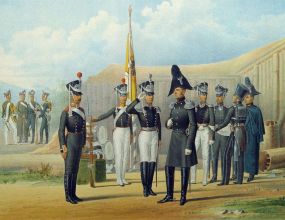 Uniforms of the Leib-Guard Sappers Battalion, 1812. Source: Picryl
Uniforms of the Leib-Guard Sappers Battalion, 1812. Source: Picryl A new chapter in the history of Roma in the Russian Empire was opened by the military duty of country's residents.
The Russian Imperial Army was founded at the end of the 17th - beginning of the 18th centuries as a result of the military reforms of Peter I as a regular army based on conscription. Conscription was a method of recruiting the armed forces of the Russian Empire until 1874. It was introduced in Russia by Peter I in 1705, when the term “recruit” was legalized in the state. As a result, by 1708, instead of approximately 40 thousand soldiers, the Russian army consisted of 113 thousand recruits. The innovation became synonymous with the warrior’s prestigious position and his social significance. The officer was, first of all, a representative of state power, and not just a military professional.
The high status of the military man was rooted in the Middle Aged Russia: carrying weapons and being a warrior was valued very highly in society. This occupation could be passed on from generation to generation and gave reason to consider one’s family as noble. Forming the state apparatus, Peter I ordered all officers to be given the rank of nobility. In 1722, he issued the Table of Ranks Law. This document was a table containing a list of correspondences between military, civilian and court ranks, ranked into 14 classes, in which the military position stood above all civil and court ranks. Thus, all persons of any origin who reached the first officer rank - ensign, received the rank of nobility, which was passed on to his wife and children which ensured social guarantees and a good life for the whole family.
All individuals of different backgrounds were a subject to conscription which meant that ethnic groups and nomadic people of the Empire were also a part of the plan. The inclusion of the people in the urban and rural classes (peasants, townspeople, merchants) implied an obligation to conscription in money equivalent or in the form of army attendance. It was one of the factors of societal unity and order. However, the Roma, unlike other ethnic groups, represented much less one unified people. This fact led authorities to take a different approach to their recruitment duties.
By the end of the 1820s - beginning of the 1830s the situation of different Roma groups varied. On the one hand, the newly joined ethnic population of the Russian Empire received national estates and with them all the accompanying rights and obligations. On the other hand, the accession of new lands required caution in political decisions, therefore, the integration of the acquired territories was accompanied by the preservation of the previous rights and obligations for the Roma and, thus, the presence of some advantages.
In 1828-1829 by the decision of Bessarabian (Moldovian) and Novorossiysk officials, the Roma were exempted from paying taxes and military contributions for 4 years. The absence of conscription was continuing since the signing of the Decree on the formation of the Bessarabian region in 1818. The reason for such concessions was another dissatisfaction with the nomadic way of life and attempts to peacefully integrate Roma into a settled living.
By the time of the 1820-30s, Roma were a semi-sedentary people. The situation varied from region to region due to political oppression of past centuries. Since the Roma traveled in families and were always on the road, they did not have a sense of ethnic unity with other camps. The additional important point was that the people never had their country before, each group of Roma had different background and didn’t feel any obligations in front of local governments or any other people except themselves. Thus, some of them accepted the proposed ranks and tried to start a new life, others rejected changes and fought for the freedom to choose their place of living.
At the same time, exemption from conscription and other monetary obligations also spreaded to residents of Feodosia and Odessa due to the need of the economic importance growth of those places as a Black Sea port. However, the benefits did not end in Bessarabia and Crimea. In the Caucasus, Roma had a number of perks over other groups of people. Those living in the villages of the Caucasus were under threat of attack by the mountaineers. At the end of the 1820s the Pyatigorsk district was devastated. The Roma became direct participants in the fight for land on an equal basis with everyone else. This was the reason for the appeal of the head of the Caucasus region E.I. Mechnikov to the Minister of Finance E.F. Kankrin with a request to forgive Roma for non-payment of state and local taxes due to financial and human losses. The request was accepted and the people were exempted from conscription duty.
Moreover, in 1831, the Recruitment Charter was updated, according to which exiled settlers in Siberia received benefits in the form of exemption from military service and payment of duties for 20 years from the date of settlement. Among such people were also Roma. In this case, the reason for the benefits was the need to populate hard-to-reach territories that needed to be filled with people.
By the 1830s, about a hundred years had already passed since the appearance of the Roma in the Russian Empire. By then, the state grew significantly in size and numbers; Roma families came to Russian lands from different parts of the world. Coming from different places, with different experiences behind, they were subservient to different rules. Although being Roma in the Caucasus or Siberia meant, for the most part, being exempt from conscription, in other parts of the country some Roma still had a very different history.